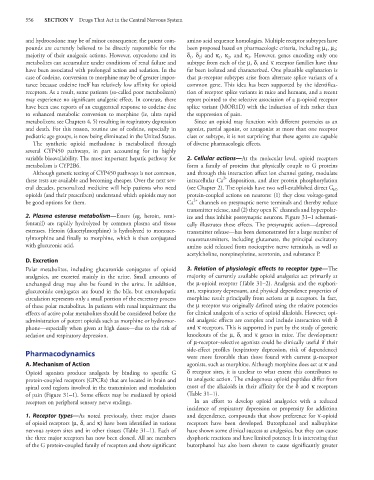Page 570 - Basic _ Clinical Pharmacology ( PDFDrive )
P. 570
556 SECTION V Drugs That Act in the Central Nervous System
and hydrocodone may be of minor consequence; the parent com- amino acid sequence homologies. Multiple receptor subtypes have
pounds are currently believed to be directly responsible for the been proposed based on pharmacologic criteria, including μ , μ ;
1
2
majority of their analgesic actions. However, oxycodone and its δ , δ ; and κ , κ , and κ . However, genes encoding only one
2
3
1
2
1
metabolites can accumulate under conditions of renal failure and subtype from each of the μ, δ, and κ receptor families have thus
have been associated with prolonged action and sedation. In the far been isolated and characterized. One plausible explanation is
case of codeine, conversion to morphine may be of greater impor- that μ-receptor subtypes arise from alternate splice variants of a
tance because codeine itself has relatively low affinity for opioid common gene. This idea has been supported by the identifica-
receptors. As a result, some patients (so-called poor metabolizers) tion of receptor splice variants in mice and humans, and a recent
may experience no significant analgesic effect. In contrast, there report pointed to the selective association of a μ-opioid receptor
have been case reports of an exaggerated response to codeine due splice variant (MOR1D) with the induction of itch rather than
to enhanced metabolic conversion to morphine (ie, ultra rapid the suppression of pain.
metabolizers; see Chapters 4, 5) resulting in respiratory depression Since an opioid may function with different potencies as an
and death. For this reason, routine use of codeine, especially in agonist, partial agonist, or antagonist at more than one receptor
pediatric age groups, is now being eliminated in the United States. class or subtype, it is not surprising that these agents are capable
The synthetic opioid methadone is metabolized through of diverse pharmacologic effects.
several CYP450 pathways, in part accounting for its highly
variable bioavailability. The most important hepatic pathway for 2. Cellular actions—At the molecular level, opioid receptors
metabolism is CYP2B6. form a family of proteins that physically couple to G proteins
Although genetic testing of CYP450 pathways is not common, and through this interaction affect ion channel gating, modulate
2+
these tests are available and becoming cheaper. Over the next sev- intracellular Ca disposition, and alter protein phosphorylation
eral decades, personalized medicine will help patients who need (see Chapter 2). The opioids have two well-established direct G
i/0
opioids (and their prescribers) understand which opioids may not protein-coupled actions on neurons: (1) they close voltage-gated
2+
be good options for them. Ca channels on presynaptic nerve terminals and thereby reduce
+
transmitter release, and (2) they open K channels and hyperpolar-
2. Plasma esterase metabolism—Esters (eg, heroin, remi- ize and thus inhibit postsynaptic neurons. Figure 31–1 schemati-
fentanil) are rapidly hydrolyzed by common plasma and tissue cally illustrates these effects. The presynaptic action—depressed
esterases. Heroin (diacetylmorphine) is hydrolyzed to monoace- transmitter release—has been demonstrated for a large number of
tylmorphine and finally to morphine, which is then conjugated neurotransmitters, including glutamate, the principal excitatory
with glucuronic acid. amino acid released from nociceptive nerve terminals, as well as
acetylcholine, norepinephrine, serotonin, and substance P.
D. Excretion
Polar metabolites, including glucuronide conjugates of opioid 3. Relation of physiologic effects to receptor type—The
analgesics, are excreted mainly in the urine. Small amounts of majority of currently available opioid analgesics act primarily at
unchanged drug may also be found in the urine. In addition, the μ-opioid receptor (Table 31–2). Analgesia and the euphori-
glucuronide conjugates are found in the bile, but enterohepatic ant, respiratory depressant, and physical dependence properties of
circulation represents only a small portion of the excretory process morphine result principally from actions at μ receptors. In fact,
of these polar metabolites. In patients with renal impairment the the μ receptor was originally defined using the relative potencies
effects of active polar metabolites should be considered before the for clinical analgesia of a series of opioid alkaloids. However, opi-
administration of potent opioids such as morphine or hydromor- oid analgesic effects are complex and include interaction with δ
phone—especially when given at high doses—due to the risk of and κ receptors. This is supported in part by the study of genetic
sedation and respiratory depression. knockouts of the μ, δ, and κ genes in mice. The development
of μ-receptor–selective agonists could be clinically useful if their
Pharmacodynamics side-effect profiles (respiratory depression, risk of dependence)
were more favorable than those found with current μ-receptor
A. Mechanism of Action agonists, such as morphine. Although morphine does act at κ and
Opioid agonists produce analgesia by binding to specific G δ receptor sites, it is unclear to what extent this contributes to
protein-coupled receptors (GPCRs) that are located in brain and its analgesic action. The endogenous opioid peptides differ from
spinal cord regions involved in the transmission and modulation most of the alkaloids in their affinity for the δ and κ receptors
of pain (Figure 31–1). Some effects may be mediated by opioid (Table 31–1).
receptors on peripheral sensory nerve endings. In an effort to develop opioid analgesics with a reduced
incidence of respiratory depression or propensity for addiction
1. Receptor types—As noted previously, three major classes and dependence, compounds that show preference for κ-opioid
of opioid receptors (μ, δ, and κ) have been identified in various receptors have been developed. Butorphanol and nalbuphine
nervous system sites and in other tissues (Table 31–1). Each of have shown some clinical success as analgesics, but they can cause
the three major receptors has now been cloned. All are members dysphoric reactions and have limited potency. It is interesting that
of the G protein-coupled family of receptors and show significant butorphanol has also been shown to cause significantly greater

